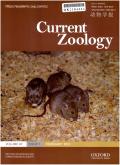The sound of fear is heritable
IF 2
2区 生物学
Q2 ZOOLOGY
引用次数: 0
Abstract
The nonlinearity and fear hypothesis predicts that highly aroused vocal mammals and birds produce vocalizations (notably alarm calls and screams) which contain a variety of non-linear phenomena (NLP). Such vocalizations often sound ‘noisy’ because vocal production systems are over-blown when animals are highly aroused. While much is known about the conditions under which animals produce vocalizations containing NLP, and how species respond to them, there is little research about the heritability of such behavioral traits. Using the quantitative genetic animal model, we estimated the genetic basis of ‘noise’ in alarm calls produced by females and found significant heritability in call entropy—our measure of the noisiness. About 9% of variance in noisiness can be accounted for by genetic differences. Taken together, these findings suggest that the degree to which marmots produce noisy calls is modestly heritable and can be thus subject to further evolution via natural selection.恐惧的声音是遗传的
非线性和恐惧假说认为,高度亢奋的哺乳动物和鸟类会发出包含各种非线性现象(NLP)的声音(尤其是报警声和尖叫声)。这种发声通常听起来很 "嘈杂",因为当动物高度兴奋时,发声系统会过度膨胀。尽管人们对动物在何种情况下会发出包含 NLP 的声音以及物种如何对其做出反应有很多了解,但有关此类行为特征遗传性的研究却很少。利用定量遗传动物模型,我们估算了雌性动物发出的报警声中 "噪音 "的遗传基础,并发现报警声熵--我们对噪音的衡量标准--具有显著的遗传性。约9%的噪音变异可由遗传差异解释。综上所述,这些研究结果表明旱獭发出嘈杂叫声的程度具有一定的遗传性,因此可以通过自然选择进一步进化。
本文章由计算机程序翻译,如有差异,请以英文原文为准。
求助全文
约1分钟内获得全文
求助全文
来源期刊

Current Zoology
Agricultural and Biological Sciences-Animal Science and Zoology
CiteScore
3.20
自引率
9.10%
发文量
111
审稿时长
6 weeks
期刊介绍:
About the Journal
Current Zoology (formerly Acta Zoologica Sinica, founded in 1935) is an open access, bimonthly, peer-reviewed international journal of zoology. It publishes review articles and research papers in the fields of ecology, evolution and behaviour.
Current Zoology is sponsored by Institute of Zoology, Chinese Academy of Sciences, along with the China Zoological Society.
 求助内容:
求助内容: 应助结果提醒方式:
应助结果提醒方式:


